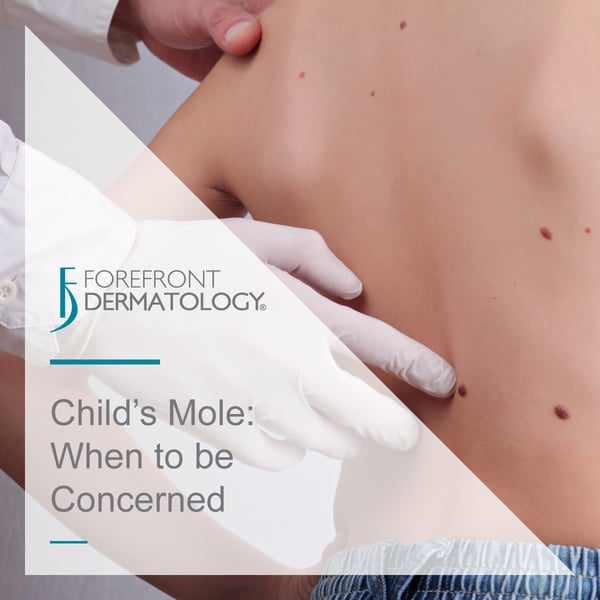
Just as we should be concerned about our own new and changing moles, we need to be concerned about our child’s moles. Dr. Sarah Campbell, board-certified dermatologist with Forefront Dermatology notes, “Generally, moles on children are nothing to worry about, but, while rare, melanoma can occur in children. Luckily, if detected early skin cancer is highly treatable.”
According to Dr. Campbell, when dermatologists educate patients on examining their own and their children’s skin, they are taught to look for the ABCDE’s.
Asymmetry
Melanoma lesions are often irregular, or not symmetrical, in shape. A non-cancerous mole is typically symmetrical in shape. If you were to draw a line through the middle of a mole, the two halves should roughly match.
Border
Typically a non-cancerous mole will have smooth, even borders. Melanoma lesions usually have irregular boarders that are difficult to define.
Color
A non-cancerous mole is commonly a single shade of brown or tan. If there is a presence of more than one color, or uneven distribution of color this can be a warning sign of melanoma. Melanoma can occur in a variety of colors including brown, black, red, blue, or purple. These spots can be flat or raised and can bleed easily. Non-melanoma skin cancer, also known as basal and squamous cell carcinoma, typically appear as small, pearly, or pale bumps or as dark red patches that can be raised, flat or scaly in texture.
Diameter
Non-cancerous moles are typically smaller than malignant ones. If its diameter is greater than a pencil eraser, it may be a sign that it is growing or changing. Larger moles that have been stable for an extended period of time are not typically cause for concern; though continued observation is recommended.
Evolving
The evolution of a mole is the most important factor to consider when performing a self-skin check. This is why monthly checks are so important. If you know what is normal, you will easily be able to tell if it has grown, or evolved, overtime.
It is also important to note that the number of moles your child has increases their risk of developing skin cancer. “It is normal for a child or teenage to get a new mole” added Dr. Campbell. “By the time they are an adult, it is common for them to have less than 20 moles. If your child already has over 50 moles, your child should be receiving annual skin cancer screenings from a dermatologist.” According to the American Academy of Dermatology, some children who have a significant amount of moles get melanoma early in life. An Australian study found that more than half of the 15 to 19-year-old patients with melanoma had at least 100 moles.
Checking not only your moles but also your child’s moles can create a lifelong habit for your child. This habit will teach your child the importance of recognizing the changes in moles and why it is important to seek out a doctor’s help if something doesn’t seem right.
Skin Struggles?
At Forefront Dermatology, we know that life is all about the moments when you don’t need us. That’s why we’re here for all the moments when you do. We offer comprehensive and compassionate care for all skin conditions and create customized treatment plans for all stages and ages – even the tiniest of patients! Find a location near you today.





